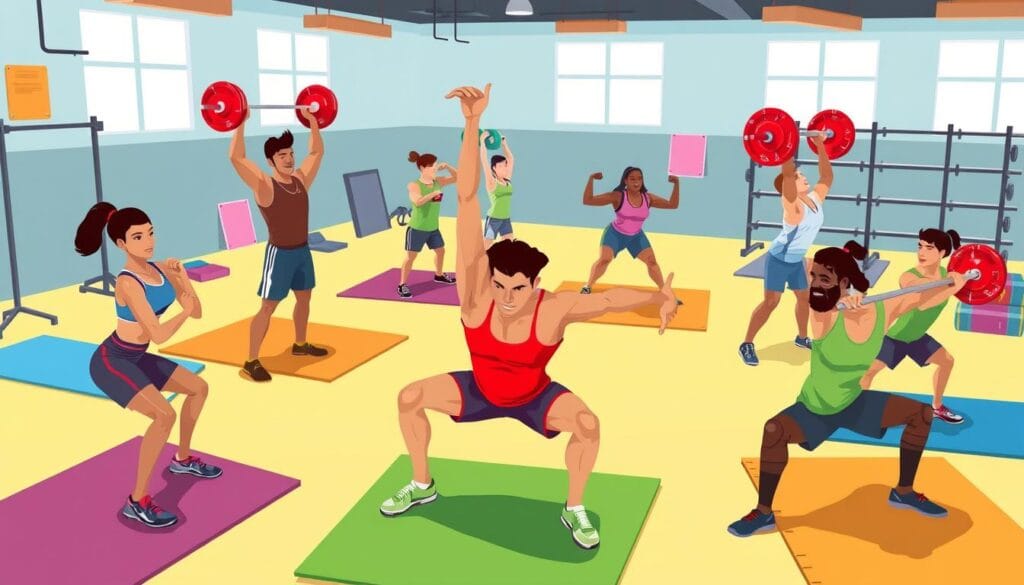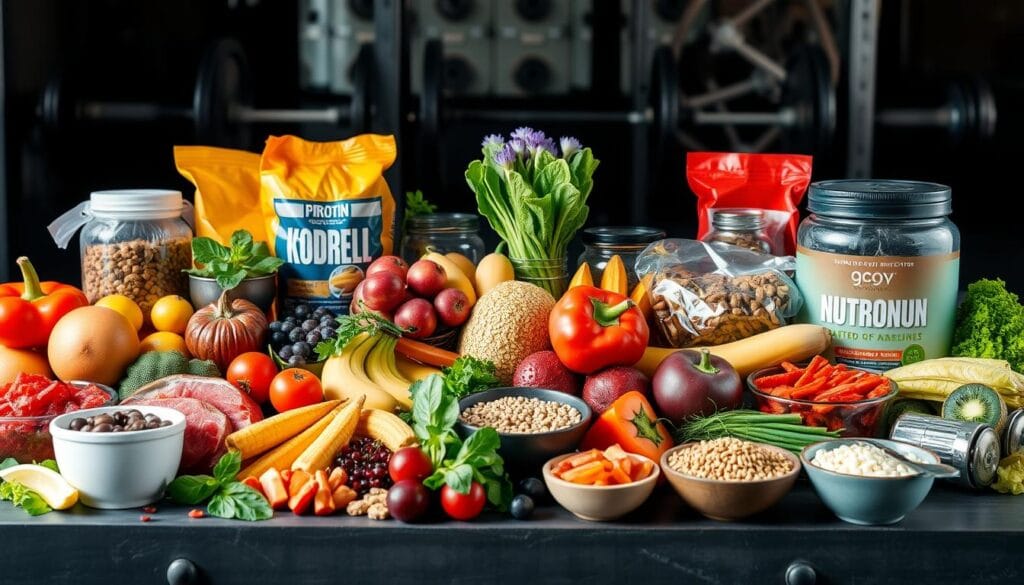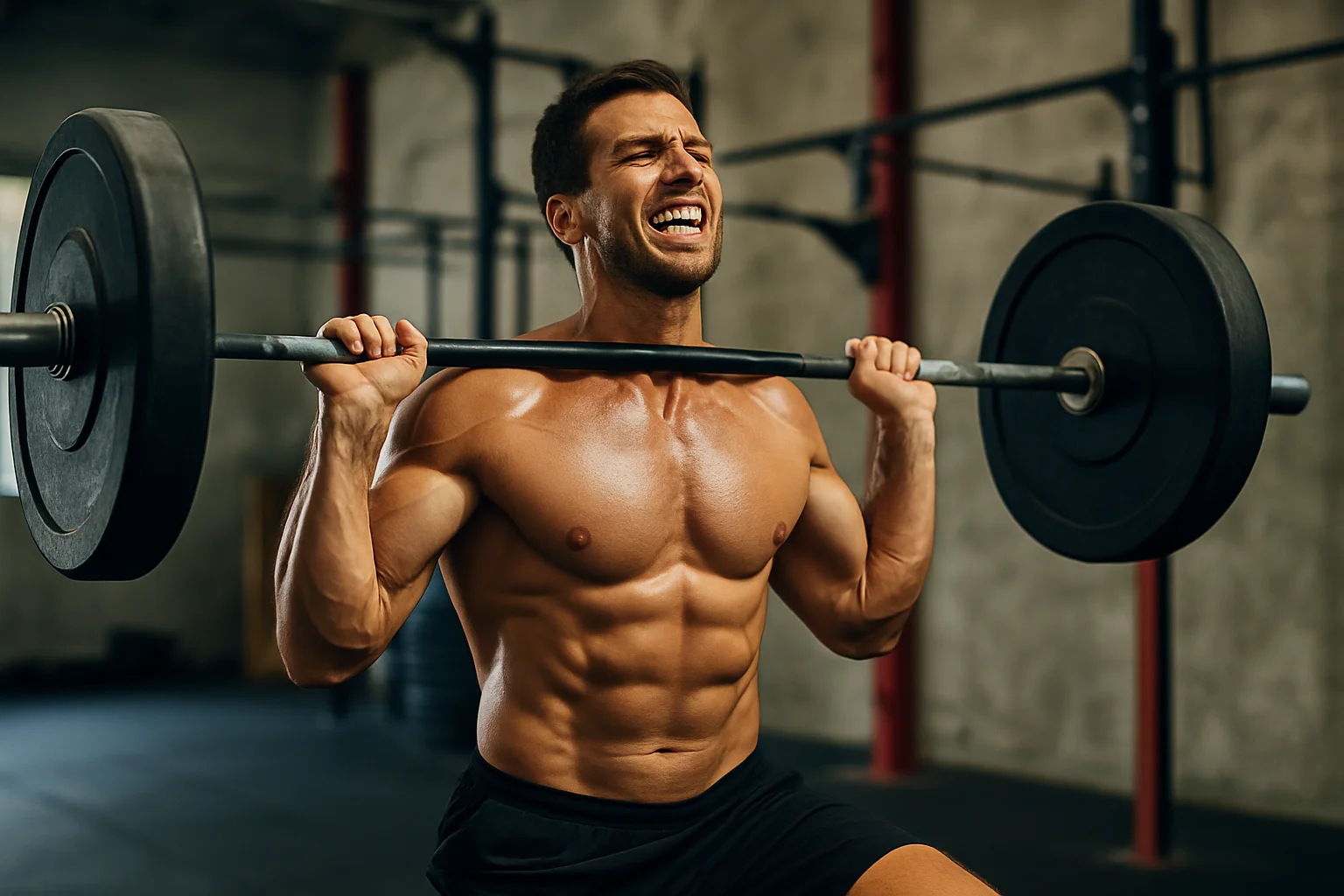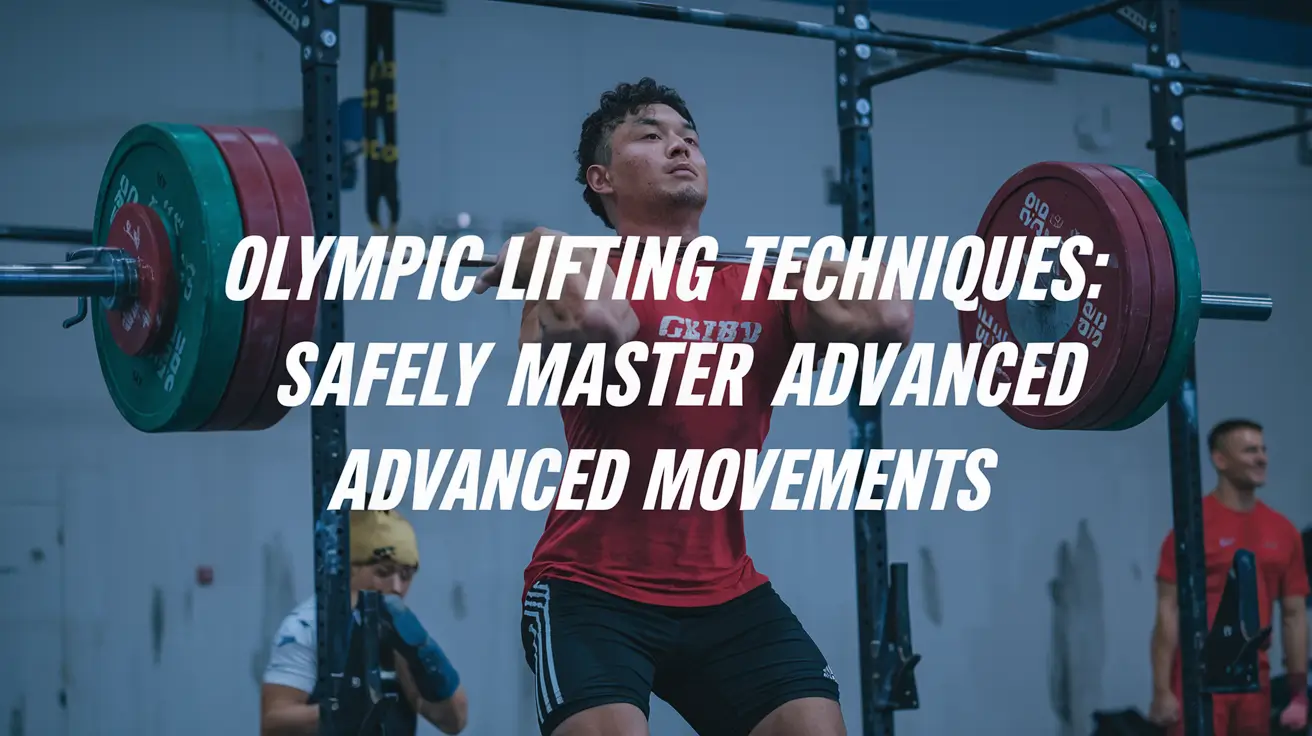As athletes, we all aim to improve our physical limits. We seek new challenges to boost our performance. Olympic weightlifting, with its focus on the snatch and clean and jerk, is a key to unlocking our potential.
I was always drawn to the power and speed of elite Olympic lifters. Their athleticism and precision seemed impossible to achieve. But, with the right training and dedication, I found that these techniques can be mastered.
Key Takeaways about Olympic Lifting Techniques
- Olympic weightlifting, centered around the snatch and clean and jerk, improves strength, speed, coordination, and flexibility.
- These advanced techniques can benefit athletes in a variety of sports, including football, soccer, volleyball, basketball, and martial arts.
- Olympic lifting programs are designed to increase explosive power and overall strength, tailored for different experience levels and goals.
- Proper guidance and dedication are essential for mastering the complex techniques of Olympic weightlifting.
- Integrating targeted exercises to build triceps strength can enhance performance in the military press, a crucial component of the clean and jerk.
In the next sections, we’ll dive into the world of Olympic lifting. We’ll cover the basic movements, benefits, and necessary equipment. Join me as we explore how to unlock your athletic potential through Olympic weightlifting.
Understanding the Basics of Olympic Lifting
Olympic lifting is a complex strength training method. It’s popular among athletes and fitness fans. It focuses on two main lifts: the snatch and the clean and jerk. These exercises boost strength and power and improve athletic skills, motor skills, and body control.
Key Benefits of Olympic Lifting
- Develops total body strength and power
- Improves athletic performance, including vertical jump, sprint speed, and agility
- Enhances motor skill development and body awareness
- Recruits multiple muscle groups, including the quads, back, shoulders, glutes, and core
Common Terminology in Olympic Lifting
Understanding Olympic lifting requires knowing some key weightlifting terminology. Here are the main terms:
- Snatch: A single-motion lift where the barbell is pulled from the floor to an overhead position in one continuous movement.
- Clean: The first half of the clean and jerk, where the barbell is pulled from the floor to the shoulders.
- Jerk: The second half of the clean and jerk, where the barbell is pushed from the shoulders to an overhead position.
- First Pull: The initial pulling motion from the floor to the mid-thigh during the snatch or clean.
- Second Pull: The explosive, accelerated pulling motion from the mid-thigh to the top of the lift.
- Turnover: The rapid transition from the first pull to the second pull, where the lifter “turns over” the barbell and catches it in the receiving position.
Learning these Olympic lifting techniques takes time and effort. But the gains in strength, power, and overall athletic development make it all worthwhile.
Essential Equipment for Olympic Lifting
Olympic weightlifting needs special gear for the snatch and clean and jerk. The right barbell and supportive equipment are key. Each piece helps you lift better and stay safe.
Choosing the Right Barbell
The barbell is the base of Olympic lifting. Look for one that’s 20kg, 28mm thick, and strong (190,000-240,000 PSI). Aggressive volcano or medium knurling helps your grip.
Importance of Olympic Weightlifting Shoes
Olympic weightlifting shoes have a high heel. This lets your ankle move freely and stay stable during lifts. It helps keep your body in the right position for explosive moves.
Using Supportive Gear Safely
- Weightlifting Belts: These belts keep your core stable, especially in heavy squats and overhead presses.
- Knee Sleeves: Knee sleeves warm up your joints and muscles, lowering injury risk.
- Lifting Straps: Straps help keep your grip strong in deadlifts and rows.
- Wrist Wraps: Wrist wraps keep your wrists stable, preventing injury in pushing and pulling.
Make sure your gear fits right and check it often for damage. The right gear boosts your performance and safety. But use it wisely and with care.
“The right equipment can make all the difference in your Olympic lifting journey. Investing in quality gear not only supports your technique but also helps prevent injuries.”
Mastering the Snatch Technique
The snatch is a key lift in Olympic weightlifting. It’s a complex move that needs precise technique and full-body coordination. Learning the snatch can boost your weightlifting skills and improve your athletic abilities.
Step-by-Step Breakdown of the Snatch
The snatch is lifting the barbell from the ground to overhead in one smooth motion. Here are the main steps:
- Setup: Stand with your feet shoulder-width apart and the barbell over your feet.
- First Pull: Use your legs and back to lift the bar, keeping it near your body.
- Second Pull: Push through your heels, extending your hips and knees for power.
- Turnover: Shrug your shoulders and pull under the bar, rotating your elbows.
- Catch: Hold the bar overhead, arms extended, and body upright.
Common Mistakes to Avoid in the Snatch
Doing the snatch right takes practice and focus. Watch out for these common mistakes:
- Pulling too early with the arms, losing power and bar control.
- Not keeping a straight bar path, leading to poor lifting and safety risks.
- Not extending hips fully in the second pull, reducing power.
Good technique is key for power and safety in the Olympic snatch. By following the steps and avoiding errors, you’ll master this challenging exercise.
“The snatch is an advanced total body strength training exercise that challenges and improves core stability, power production, and full-body coordination.”
Whether you’re experienced or new, working on the snatch technique can elevate your athletic performance and physical growth.
Perfecting the Clean and Jerk
The clean and jerk is a key Olympic weightlifting movement. It combines two powerful actions: the clean and the jerk. Learning this complex technique is key to getting the most out of this full-body exercise.
Phases of the Clean Movement
The clean part of the lift has several important phases. First, we drive through our heels to lift the bar from the floor. Then, we shrug our shoulders and extend our hips to speed up the bar.
As the bar gets close to our shoulders, we do a turnover. This aggressively pulls us under the bar to catch it in the front rack position. Finally, we end the clean with a front squat to keep the bar on our shoulders.
Transitioning from Clean to Jerk
Smoothly moving from the clean to the jerk is key for success. We start the jerk by dipping at the knees and hips. Then, we drive powerfully through our legs to press the bar overhead.
The jerk can be done in different ways, like the split jerk, power jerk, or squat jerk. Each has its own special techniques and requirements.
Analyzing Jerk Techniques
Good jerk technique is vital for lifting heavy weights overhead safely and efficiently. We must keep our torso tight and upright throughout. This ensures the bar path stays vertical.
It’s important to sync the dip, drive, and final overhead lock-out. This helps us use our maximum power and stability.
By regularly practicing the clean and jerk, we can improve our clean and jerk technique. This unlocks the full potential of Olympic weightlifting movements. It also helps us master advanced jerk variations to boost our strength and power.
“The clean and jerk is a true test of total-body strength and power. Mastering the technique is a rewarding journey that can transform your fitness level.”
Advanced Olympic Lifting Techniques
As weightlifters get better, learning advanced techniques is key. It helps unlock new power and performance levels. Understanding speed, power, and using dynamic movements and accessory exercises are crucial.
The Role of Speed and Power
Olympic lifting needs a lot of speed and power. Elite weightlifters can create maximum force quickly. The squat jerk is a key technique that tests this skill.
The squat jerk improves movement, coordination, and speed. It’s great for those who can squat comfortably. Adding it to your training can be very beneficial.
Incorporating Dynamic Movements
- Hang Cleans: Start from the hang position to focus on explosive power from the legs and hips.
- Hang Snatches: Like hang cleans, hang snatches focus on speed and coordination in the movement.
- Power Cleans and Power Snatches: These catch the barbell upright, boosting power and speed.
Utilizing Accessory Exercises
Adding accessory exercises to main lifts can improve power and technique. Here are some examples:
- Pull Variations: Deadlifts, Romanian deadlifts, and others strengthen the back and improve pulling.
- Plyometric Exercises: Box jumps, depth jumps, and others build explosive power and quickness.
- Core Stability Exercises: Planks, ab wheels, and others help stabilize the body for lifting.
By adding these advanced techniques and exercises to your training, you’ll see big improvements. You’ll get better at advanced weightlifting techniques, power development, and dynamic lifting.
Importance of Mobility and Flexibility
For weightlifters, keeping our bodies mobile and flexible is key to success. Good warm-ups and stretches boost our performance, lower injury risks, and make us feel better overall.
Pre-Lifting Warm-Up Practices
Before we start lifting, we need to warm up. Doing dynamic stretches like ankle circles and leg swings helps our ankles move better. This is important for lifting well. Research shows dynamic stretches are better than static or ballistic ones for muscle power.
Stretching Techniques for Lifters
Stretching is also vital. Olympic lifters should stretch their ankles, hips, shoulders, and wrists. Tests like the Weight-bearing lunge test help us see where we need to improve and track our progress.
By focusing on weightlifting mobility and flexibility for Olympic lifting with good warm-up routines, we can reach our best, avoid injuries, and succeed more in the sport.

| Mobility Benefits | Percentage Improvement |
|---|---|
| Increased Power | 12% |
| Reduced Injury Risk | 20% |
| Improved Posture | 18% |
| Stress Reduction | 15% |
“Mobility training can lead to enhanced performance, reduced injury risk, pain relief, improved posture, and stress reduction, highlighting its wide range of benefits for athletes and individuals seeking overall well-being.”
Developing a Personalized Training Program
Creating a good Olympic lifting program needs a personal touch. It should match your goals, skill level, and physical abilities. Focusing on the main Olympic lifts helps you grow and get lasting results.
Structuring Workouts around Olympic Lifting
Our workouts mix technique drills, strength exercises, and accessory work. First, we focus on perfecting the snatch, clean, and jerk. This builds a strong base.
Then, we use squats, deadlifts, and overhead presses for strength. We add special exercises to fix any weak spots.
Setting Realistic Goals and Progress Tracking
It’s important to set goals you can reach and track your progress. We aim to boost your lift percentages, improve technique, or enhance fitness. We’ll create a plan for your success.
By watching your lift volumes and percentages, we adjust your program. This keeps you motivated on your fitness path.
Creating a personalized Olympic lifting program unlocks your full potential. Tailored workouts, realistic goals, and tracking your progress lead to mastering these complex lifts. You’ll reach your fitness goals.
“Personalized training programs are the foundation for long-term success in Olympic lifting. By addressing individual needs and consistently tracking progress, we empower our athletes to reach new heights.”
| Metric | Baseline | Goal | Current |
|---|---|---|---|
| Snatch | 145 lbs | 165 lbs | 155 lbs |
| Clean and Jerk | 185 lbs | 205 lbs | 195 lbs |
| Squat | 245 lbs | 275 lbs | 260 lbs |
| Deadlift | 315 lbs | 345 lbs | 330 lbs |
Nutrition and Recovery Strategies
Olympic weightlifters need to fuel their bodies right for top performance and quick recovery. Knowing the basics of weightlifting nutrition helps us get the right nutrients. This makes sure our training is supported and our bodies ready for intense competition.
Fueling Our Bodies for Performance
Protein is key for muscle repair and growth. Complex carbs and healthy fats give us the energy for tough weightlifting sessions. It’s also important to eat at the right times to boost performance and recovery.
Everyone’s dietary needs are different. It’s okay to have “cheat meals” as long as we meet our nutrient needs for weightlifting success.
Recovering from Intense Training Sessions
Good recovery is vital, including enough sleep, staying hydrated, and using techniques like foam rolling and massage. These recovery techniques help our bodies heal and keep us performing at our best.
“Fueling our bodies with the right nutrients and implementing effective recovery strategies are essential for Olympic weightlifters to push the limits of their abilities and achieve their goals.”
Success in weightlifting nutrition comes from finding a balance that suits you. This lets you train hard, recover well, and do great in the sport you love.

Safety and Injury Prevention
Maintaining weightlifting safety is key for athletes and fitness fans. Using the right technique and increasing weights slowly helps avoid injury. By sticking to best practices and spotting overtraining signs, we can safely enjoy Olympic lifting.
Best Practices for Lifting Safely
To lift safely, we need to use spotters, check our gear often, and follow a good program. These steps help us avoid accidents and let us improve without risking our health.
Recognizing Signs of Overtraining
It’s important to listen to our bodies to avoid overtraining. Feeling tired all the time, not doing as well, and mood swings are signs. Spotting these early helps us adjust our training and recover, improving our progress and safety.
| Symptom | Description |
|---|---|
| Persistent Fatigue | Feeling tired even after adequate rest and recovery |
| Decreased Performance | Inability to lift previous weights or complete exercises with the same intensity |
| Mood Changes | Increased irritability, anxiety, or depression |
By focusing on weightlifting safety and watching for overtraining signs, we can reach our best in Olympic lifting. This way, we protect our health and well-being for the long run.
Joining the Olympic Lifting Community
Joining the Olympic lifting community can really boost your training and motivation. You’ll find local clubs and meet qualified coaches. This gives you expert advice and the support of people who share your passion.
Competitions and events let you test your skills and set new records. They also offer a chance to feel part of a community.
Finding Local Clubs and Coaches
Finding a good Olympic weightlifting club near you can change your game. These clubs have experienced coaches who can help you improve. They offer personalized training and feedback to help you get better.
Look for clubs in your area, search online, or ask national governing bodies. They can help you find the best coaches and clubs.
Benefits of Competing and Participating in Events
Competing in Olympic lifting can be very rewarding. You can join local, regional, or national events. This lets you test your skills against others and push yourself to do better.
Events offer a sense of community and the thrill of setting new records. You also learn from more experienced athletes. This makes events a great opportunity for anyone serious about Olympic weightlifting.
Frequently Asked Questions
What are the two main lifts in Olympic weightlifting?
The two main lifts in Olympic weightlifting are the snatch and the clean and jerk. Mastering these movements is key to unlocking athletic potential.
What are the benefits of Olympic lifting?
Olympic lifting develops total body strength and power, improves athletic performance (like vertical jump and sprint speed), enhances motor skills and body awareness, and recruits multiple muscle groups such as the quads, back, shoulders, glutes, and core.
What equipment is essential for Olympic lifting?
Essential equipment includes a quality Olympic barbell (typically 20kg, 28mm thick), Olympic weightlifting shoes with a raised heel for ankle mobility and stability, and supportive gear like weightlifting belts, knee sleeves, lifting straps, and wrist wraps used safely and appropriately.
How do you perform the snatch technique?
The snatch is lifting the barbell from the ground to overhead in one continuous motion. Key steps include setup (feet shoulder-width, bar over feet), the first pull (lifting with legs/back, bar near body), the second pull (explosive hip/knee extension), turnover (shrug, pull under bar), and catch (bar overhead, arms extended, body upright).
What are the phases of the clean and jerk?
The clean involves pulling the bar from the floor to the shoulders, including driving through heels, shrugging shoulders, hip extension, and catching the bar in the front rack position, often followed by a front squat. The jerk follows, involving a dip at knees/hips and a powerful drive through legs to press the bar overhead. Common jerk techniques include the split jerk, power jerk, and squat jerk.
Why are mobility and flexibility important for weightlifters?
Mobility and flexibility are crucial for weightlifters to improve performance, lower injury risks, and maintain overall well-being. Good warm-up routines with dynamic stretches and targeting areas like ankles, hips, shoulders, and wrists with stretching are vital for proper technique and movement.
How can I ensure safety and prevent injury in Olympic lifting?
Maintaining weightlifting safety involves using the correct technique, gradually increasing weights, using spotters, checking equipment regularly, and following a structured program. It's also important to recognize signs of overtraining, such as persistent fatigue, decreased performance, and mood changes, to adjust training and prevent injury.



